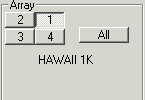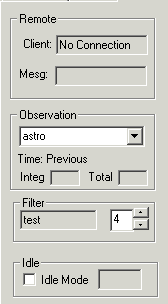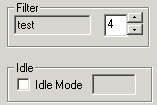
See the Perkin Elmer online help for the other features not described here.
The infrared version of pixcel has two extra tabs on the panel at the left of the screeen, labelled Infrared and Observe these contain the extra functions and controls.

The controls are split into four main areas,
This display shows the array configuration in the selected camera.


This display reflects the arrangement of the detectors in the instrument. Each detector is made up of four independent quadrants, this control allows any pattern of quadrants to be read. The above example shows all of the first chip of CIRSI selected. Pressing the ALL key will select all the quadrants and pressing again de-selects all.

Two readout modes are available.
- Read-Reset-read (RRR) mode is used with high background observations to give a short exposure time with very high duty cycle.
- Non-Destructive-Read (NDR) mode is the classical readout mode for infrared arrays. It allows the array to be read repeatedly during a long exposure. This mode is also used for the live grab operation.

The readout sequence for the infrared camera is based around a loop. All the selected detectors are reset and then read a number of times, the data is saved and the system integrates for the exposure time. The detectors are then read again and the cycle continues for the number of loops.The exposure time box sets the number of seconds to integrate for. The box immediately to the left shows the minimum exposure time for the pixel_rate and number of quadrants selected.
In RRR mode the number of exposures to make is set by the No. Loops box - each exposure is independent of the one before and takes the number of seconds set in the exposure time box. The total integration time is the no of loops multiplied by the exposure time. The No Reads box doesn't apply and is disabled.
In NDR mode a sequence consists of one integration read repeatedly. The number of loops sets the number of times through the exposure to perform a read. The number of reads box sets the number of reads to perform at each loop. To do multiple reads at the start and end, set loops=1 and reads = the number of reads you want. The exposure is the total time between the first and last reads.
The product of the number of quadrants the number of reads and the number of loops is limited by the memory available in the computer.

The system writes the data as standard fits files. If possible the data is written during the exposure before the next loop, if there isn;t enough time the data is written at the end. In both cases all the data for the sequence is kept in memory. (hint: see the SAVE_TIME entry in configuration section ) If the subtract box is set the reset level is subtrracted from each frame before the data is saved. In NDR mode this is the first frame, in RRR mode this is the reset region of the preceding read.
The object box contains a name for the object, this is listed in the fits header and can also be made part of the filename. The path is the directory to write the data into, this can be in the traditional dos format drive:\directory or unified name convention (UNC) format \\machine\share\directory
This box also contains the run number, this is an automatically incremented serial number which uniquely identifies each sequnce. The files box contains the number of individual files which will be written for this sequence.

Other lesser controls for observing are on the observing tab. These do not directly control the program but allow settings in the fits header and monitor the remote control.

This shows the ip address of the current remote control client and the last command sent.

The observation type can be selected from the pull down menu, or set by the remote control. It is used in the fits header.
This box also shows the requested exposure time and the actual measured expsoure for the last sequence.

The current filter can be selected from the pull down menu, or set by the remote control. It is used in the fits header. Currently the filter wheel in cirsi is not automated.